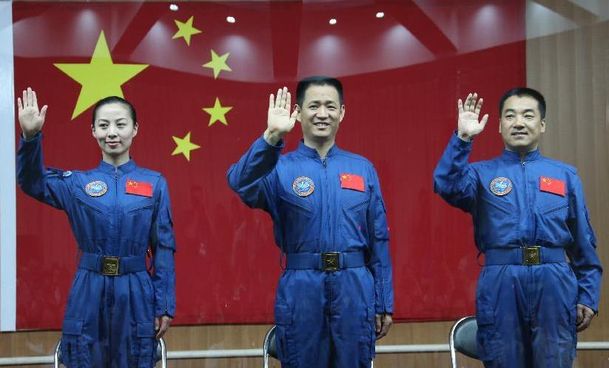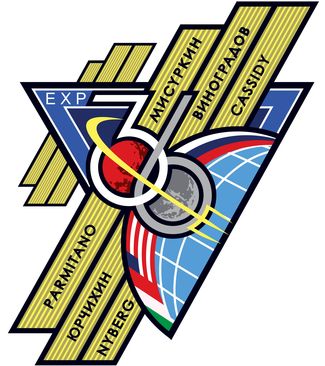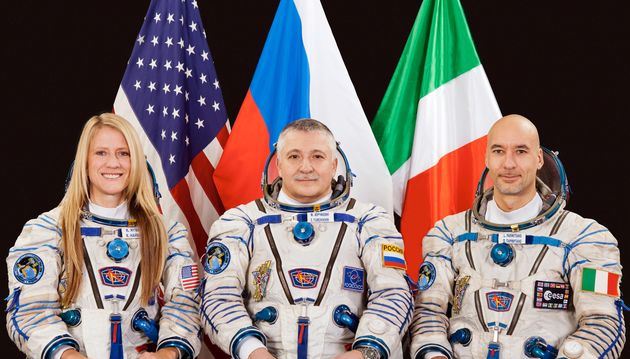Main » Entries archive
 Shenzhou-10 docked with space module. Shenzhou-10 docked with space module.
On June 13, 2013 at 05:18 UTC the Chinese "Shenzhou-10” manned spacecraft successfully completed an automated docking with the "Tiangong-1” space module. Three Chinese cosmonauts (Nie Haisheng, Zhang Xiaoguang, Wang Yaping) aboard the "Shenzhou-10” monitored and reported the docking operation to the control center.
The docking procedure was the fifth to take place between Shenzhou-type spacecraft and the space module. Previous dockings include two automated operations by the unmanned Shenzhou-8 in 2011 and both an automated and manual docking by the manned Shenzhou-9 in 2012.
At the same day at 08:17 UTC the hatches between the spacecraft and the "Tiangong-1” module was opened and the cosmonauts entered the space module to carry out scientific and technical experiments.
|
 Russian “Progress” spacecraft undocked from the Space Station. Russian “Progress” spacecraft undocked from the Space Station.
On June 11, 2013 at 13:58 UTC the Russian "Progress M-19M” unmanned supply spacecraft was undocked from the Russian "Zvezda” ("Star”) module of the International Space Station for a weeklong flight to study the operation of its liquid-propellant engines in the ionosphere, which spans from 50 to 250 miles above the Earth’s surface. The deorbiting of "Progress M-19M” is to be performed on June 19.
|
 China launched a manned spacecraft. China launched a manned spacecraft.
On June 11, 2013 at 09:38 UTC the "Shenzhou-10” (神舟十号) manned spacecraft was launched from Chinese Jiuquan Cosmodrome in Jiuquan, northwest China's Gansu Province.
The space vehicle was orbited by the Chinese "Chang Zheng-2F” (Long March 2F 长征二号F运载火箭) rocket-carrier. 
The spacecraft is piloted by 3 cosmonauts: Commander, Nie Haisheng (聂海胜) (center); operator, Zhang Xiaoguang (张晓光) (right); assistant, Wang Yaping (王亚平) (left) who is female.
The space vehicle is to dock with China's "Tiangong-1” space station on June 13.
|
 Russia launched a military satellite. Russia launched a military satellite.
On June 7, 2013 at 18:37 UTC the Russian "Soyuz-2.b” rocket-carrier was launched from Plesetsk Cosmodrome, Arkhangelsk region, North Russia. The rocket orbited the "Kosmos-2486” reconnaissance satellite to collect high-resolution imagery for Russia's strategic forces and intelligence agencies.
Looking through: 1486 |
Date: 11.06.2013
| Rating: 0.0/0
|
 ATV-4 spacecraft launch to Space Station. ATV-4 spacecraft launch to Space Station.
On June 5, 2013 at 21:52 UTC the ATV-4 "Albert Einstein” European unmanned supply spacecraft was launched from the Kourou space center in French Guiana to deliver cargo to the International Space Station. The space vehicle was orbited by the Ariane-5ES rocket-carrier.
The fourth Automated Transfer Vehicle (ATV), named after 20th century theoretical physicist Albert Einstein, is scheduled to dock with the aft port of the Russian "Zvezda” module on June 15.
|
 Russian “Proton” rocket orbited a telecoms satellite. Russian “Proton” rocket orbited a telecoms satellite.
On June 3, 2013 at 09:18 UTC the Russian "Proton-M” rocket-carrier was launched from Baykonur Cosmodrome. The rocket equipped with the "Briz-M” booster orbited the SES-6 telecommunications satellite.
The SES-6 is built by Astrium for global satellite operator SES World Skies and has a service life of 15 years. The 6100 kg satellite will deliver the next generation broadcast services, including HD video distribution and mobile services, to customers in North America, Latin America, Europe and the Atlantic Ocean.
It was the 4th launch of a "Proton” rocket in 2013 and the 387th launch of a rocket of "Proton” series.
Looking through: 1414 |
Date: 04.06.2013
| Rating: 0.0/0
|
 Russian Soyuz TMA-09M spacecraft docked to the ISS. Russian Soyuz TMA-09M spacecraft docked to the ISS.
On May 29, 2013 at 02:10 UTC the "Soyuz TMA-09M” spacecraft docked with the Russian "Rassvet” ("Daybreak”) module of the International Space Station in automatic regime just only about 5 hours and 39 minutes after the launch.
The Soyuz TMA-09M delivered three new members of Expedition 36 to the ISS, Russian cosmonaut Fjodor Yurchikhin, Italian astronaut Luca Parmitano and American astronaut Karen Nyberg.
The hatches between the spacecraft and the station were opened at 04:14 UTC. 
The new comers joined current ISS expedition members - Russian cosmonauts Pavel Vinogradov and Alexander Misurkin as well as American astronaut Chr
...
Read more »
|
 Russia launched Soyuz TMA-09M manned spacecraft. Russia launched Soyuz TMA-09M manned spacecraft.
On May 28, 2013 at 20:31 UTC (on May 29 at 00:31 Moscow time) the Russian "Soyuz TMA-09M” spacecraft was launched from Baykonur Cosmodrome. The space vehicle was orbited by the Russian "Soyuz-FG” rocket-carrier.
The spacecraft is piloted by 3 cosmonauts: Commander, Russian cosmonaut Fjodor Yurchikhin (center); flight-engineer, Italian astronaut Luca Parmitano (right); flight-engineer, American astronaut Karen Nyberg (left).
The space vehicle is to dock with the International Space Station just after 4 orbits. 
Photo by the Gagarin Cosmonaut Training Centre.
Yurchikhin, Parmitano and Nyberg will join cur
...
Read more »
|
 US launched a military satellite. US launched a military satellite.
On May 25, 2013 at 00:27 UTC the "Delta-4M” rocket-carrier was launched from Cape Canaveral launch site of US Air Force. The launch was performed by United Launch Alliance supported by the 45th Space Wing of US Air Force. The rocket orbited the WGS-5 (Wideband Global SATCOM-5) military communications satellite.
The satellite, which costs $342 million and weighs about 6000 kilograms, is the fifth installment in a high capacity communications system co-developed by US and Australian defense agencies.
Looking through: 1503 |
Date: 26.05.2013
| Rating: 0.0/0
|
 Space capsule returned cosmic rodents to Earth after a month flight. Space capsule returned cosmic rodents to Earth after a month flight.
On May 19, 2013 the returnable capsule of the "Bion-M” biological research satellite landed in a distance of 100 kilometers northeast of the city of Orenburg Region, Russia.
The descent vehicle separated from the equipment module of the Bion-M spacecraft at 6:32 a.m. Moscow time (02:32 UTC). After successfully passing through the dense layers of the Earth’s atmosphere, the capsule landed at 07:12 Moscow time at the designated area.
Russian space officials announced that a capsule containing mice and lizards has returned to Earth, but most of them died during their time in space, according to media reports.
The Bion-M capsule carried 45 mice, 15 newts, snails, lizards, plants, microflora, and eight gerbils, but majority of the mice and newts failed to survive, while all of the gerbils perished.
The trip was to test the effects of microgravity on living organisms' skeletons, nervous systems, muscles and hearts.
...
Read more »
Looking through: 1404 |
Date: 21.05.2013
| Rating: 0.0/0
|
|





